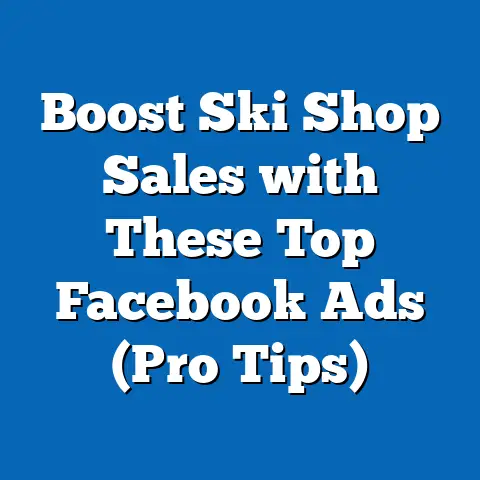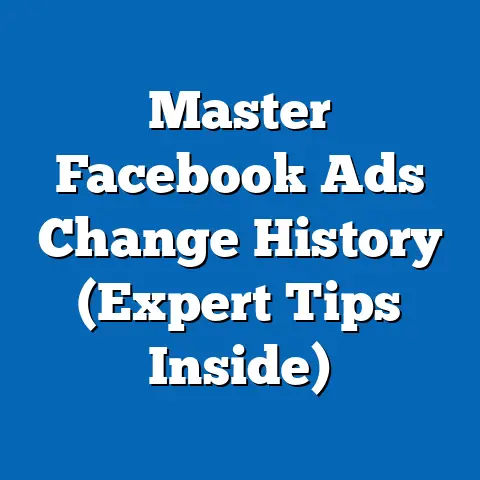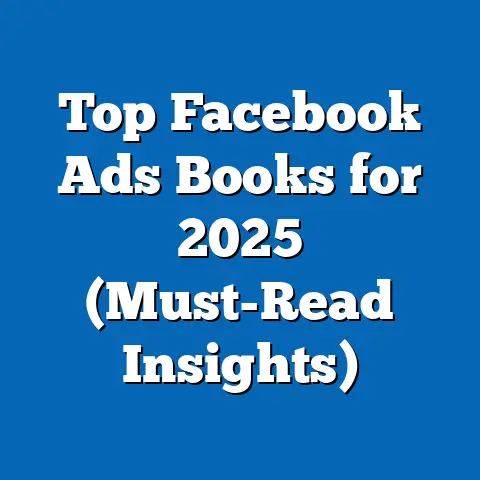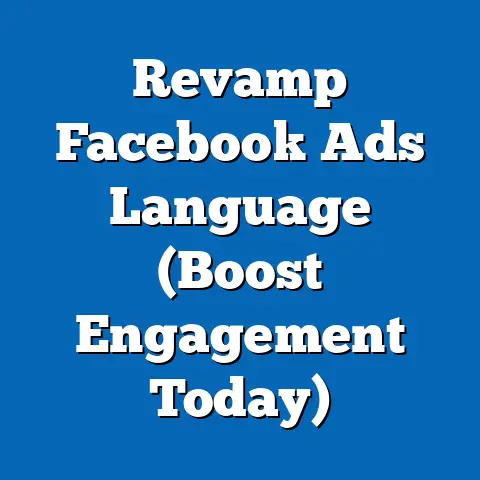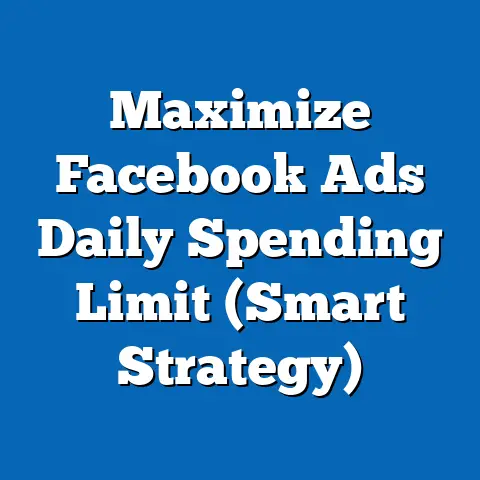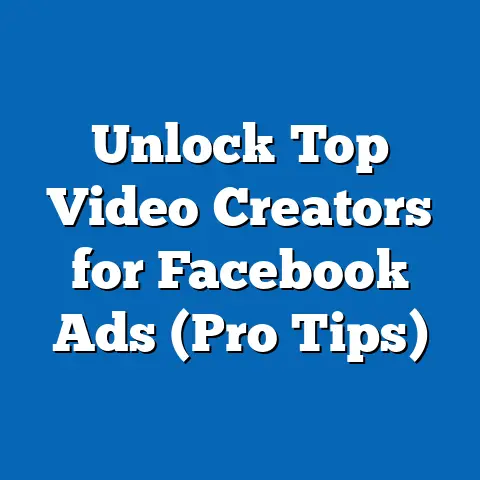Mastering Interest Changes in Facebook Ads (Strategic Insights)
The world of digital advertising is a relentless current, constantly shifting and demanding agility. And while flashy new platforms and algorithms grab headlines, the bedrock of effective advertising remains timeless: understanding your audience. Nowhere is this more crucial than on Facebook, where interest targeting can make or break your campaign. I’ve seen firsthand how mastering these interest changes can transform a struggling campaign into a roaring success, and conversely, how ignoring them can lead to wasted ad spend and frustrating results. In this guide, I’ll walk you through the evolution of audience interests, how Facebook’s targeting works, and the strategies you need to stay ahead of the curve and ensure your ads resonate with the right people at the right time.
The Evolution of Audience Interests
The way we connect and express ourselves online has undergone a dramatic transformation. This evolution directly impacts how we target audiences and craft effective advertising campaigns.
Historical Context: From Simple Categories to AI-Powered Insights
Back in the day, Facebook’s interest targeting was relatively basic. We were limited to selecting from a pre-defined list of categories like “Sports,” “Music,” or “Technology.” This approach worked, to some extent, but it was broad and often inaccurate. Think of it like trying to catch fish with a giant net – you might catch some of the fish you want, but you’ll also haul in a lot of unwanted “bycatch.”
Now, Facebook’s algorithms are far more sophisticated. They analyze user behavior – the pages we like, the posts we engage with, the groups we join, and even the websites we visit – to build incredibly detailed profiles of our interests. It’s like having a personalized fishing rod that’s specifically designed to catch the exact type of fish you’re after. This shift from simple categories to AI-powered insights has revolutionized targeting, enabling us to reach hyper-specific audiences with laser precision.
User Behavior Trends: Riding the Waves of Change
User behavior isn’t static; it’s a dynamic force shaped by societal shifts, technological advancements, and cultural trends. Think about the rise of mobile gaming, the surge in popularity of sustainable living, or the ever-evolving landscape of social justice movements. Each of these trends has a ripple effect on user interests, creating new niches and reshaping existing ones.
For example, I remember working with a client who sold eco-friendly cleaning products. Initially, we targeted broad interests like “Green Living” and “Organic Products.” While we saw some success, we noticed that engagement was highest among users who also showed interest in specific sustainable practices like “Composting” and “Zero Waste.” By refining our targeting to include these niche interests, we significantly improved our ad performance and reached a more engaged audience.
Staying on top of these trends requires constant vigilance. We need to be aware of what’s happening in the world and how it’s influencing user behavior. This means reading industry news, engaging with online communities, and keeping a close eye on social media trends.
The Role of Data Analytics: Your Crystal Ball for Predicting the Future
Data analytics is no longer a luxury; it’s a necessity. By tracking engagement metrics, analyzing user interactions, and monitoring campaign performance, we can gain valuable insights into how audience interests are changing. This data-driven approach allows us to refine our targeting strategies, optimize our ad creative, and ultimately, maximize our ROI.
I personally rely heavily on Facebook Analytics and third-party tools to track key metrics like click-through rates (CTR), conversion rates, and cost per acquisition (CPA). By analyzing these metrics over time, I can identify patterns and trends that reveal how audience interests are evolving. For example, if I notice that CTR is declining for a particular interest category, it might be a sign that the audience is becoming fatigued with our ads or that the interest itself is losing relevance.
Key Takeaway: Audience interests are constantly evolving, driven by societal shifts, technological advancements, and cultural trends. Leverage data analytics to stay ahead of the curve and adapt your targeting strategies accordingly.
Understanding Facebook’s Interest Targeting
Facebook’s interest targeting is a powerful tool, but it’s only effective if we understand how it works and how to use it strategically.
Mechanics of Interest Targeting: How Facebook Connects Ads to People
Facebook’s interest targeting relies on a vast database of user data, collected from our activity on and off the platform. This data is used to categorize users into different interest groups, based on the pages they like, the posts they engage with, the groups they join, and even the websites they visit.
There are two main types of interests we can target:
- Broad Categories: These are general interests like “Sports,” “Travel,” or “Fashion.” They’re useful for reaching a large audience, but they can also be less targeted and less effective.
- Niche Interests: These are more specific interests like “Sustainable Fashion,” “Backpacking,” or “NBA Basketball.” They’re ideal for reaching a highly targeted audience with a specific message.
The key is to choose interests that are relevant to our brand and our target audience. This requires careful research and a deep understanding of who we’re trying to reach.
The Importance of Relevance: Connecting with the Right Audience
Relevance is the cornerstone of effective advertising. If our ads aren’t relevant to the audience we’re targeting, they’re likely to be ignored or even perceived as annoying. Irrelevant targeting leads to wasted ad spend, lower engagement rates, and ultimately, a poor ROI.
Imagine you’re trying to sell vegan protein powder. Targeting users who are interested in “Meat Lovers” or “BBQ” would be a complete waste of time and money. Instead, you’d want to target users who are interested in “Veganism,” “Plant-Based Diets,” or “Fitness.” By focusing on relevant interests, you’re more likely to reach users who are actually interested in your product and more likely to convert into customers.
Tools and Features: Unlocking the Power of Facebook’s Resources
Facebook provides a range of tools and features to help us identify and analyze interests. These tools can be invaluable for refining our targeting strategies and maximizing our ad performance.
- Audience Insights: This tool provides detailed information about the demographics, interests, and behaviors of our target audience. We can use it to explore different interest categories, identify potential niches, and gain a deeper understanding of who we’re trying to reach.
- Ads Manager: This is the central hub for creating and managing our Facebook Ads campaigns. It allows us to select our target audience, set our budget, create our ad creative, and track our performance. Within Ads Manager, the “Detailed Targeting” section allows us to browse and search for interests.
- Facebook Pixel: This is a small piece of code that we install on our website. It tracks user behavior on our site, allowing us to retarget users who have previously visited our site and to create custom audiences based on their actions.
By mastering these tools and features, we can unlock the full potential of Facebook’s interest targeting and create highly effective advertising campaigns.
Key Takeaway: Facebook’s interest targeting is a powerful tool, but it’s only effective if you understand how it works, choose relevant interests, and leverage Facebook’s tools and features effectively.
Strategies for Mastering Interest Changes
Staying ahead of the curve in the ever-evolving world of Facebook Ads requires a proactive and adaptive approach. Here are some key strategies I’ve found invaluable:
Continuous Research and Monitoring: Keeping Your Finger on the Pulse
The digital landscape is in perpetual motion, and what works today might be obsolete tomorrow. That’s why continuous research and monitoring are non-negotiable. This isn’t a one-time task; it’s an ongoing process of staying informed, observant, and adaptable.
How to Stay Informed:
- Industry News: Regularly read industry publications, blogs, and newsletters to stay abreast of the latest trends and best practices.
- Social Listening: Monitor social media channels for conversations and trends related to your industry and target audience. Use tools to track keywords, hashtags, and mentions to gain real-time insights.
- Competitor Analysis: Keep an eye on what your competitors are doing. Analyze their ad campaigns, targeting strategies, and engagement rates to identify potential opportunities and learn from their successes and failures.
Engaging with Communities:
- Join Relevant Groups: Participate in Facebook groups and online forums related to your industry and target audience. This allows you to engage directly with potential customers, ask questions, and gain valuable insights into their interests and needs.
- Attend Industry Events: Attend conferences, webinars, and workshops to network with other professionals, learn about new technologies, and gain insights from industry experts.
Dynamic Ad Strategies: Adapting on the Fly
Static ad campaigns are a recipe for disaster. To truly master interest changes, you need dynamic ad strategies that can adapt to real-time data and trends.
What are Dynamic Ads?
Dynamic ads automatically adjust their content, targeting, and bidding based on user behavior and performance data. This allows you to personalize the ad experience for each individual user, increasing engagement and conversion rates.
Example:
I once worked with an e-commerce client who sold personalized gifts. Instead of running static ads that promoted all of their products, we implemented dynamic ads that showcased products based on each user’s browsing history and interests. If a user had previously viewed personalized mugs on their website, they would see ads promoting personalized mugs. This resulted in a significant increase in click-through rates and conversion rates.
A/B Testing: The Scientific Method for Advertising
A/B testing, also known as split testing, is a powerful tool for understanding audience preferences and optimizing your ad campaigns. It involves creating two or more versions of an ad, each with a different element (e.g., headline, image, call-to-action), and then showing them to different segments of your target audience. By tracking the performance of each version, you can identify which elements resonate best with your audience and make informed decisions about your ad creative and targeting.
How to A/B Test Interests:
Create multiple ad sets, each targeting a different interest category. Keep all other variables constant (e.g., budget, ad creative, bidding strategy) so that you can accurately compare the performance of each interest. Track key metrics like click-through rates, conversion rates, and cost per acquisition to determine which interests are most effective.
Leveraging Custom Audiences: Reaching Your Ideal Customers
Custom Audiences allow you to target specific groups of people based on their existing relationship with your business. This can include customers who have purchased from you in the past, website visitors, email subscribers, or even users who have engaged with your content on Facebook.
How to Use Custom Audiences:
- Upload Your Customer List: Upload your customer list to Facebook to create a Custom Audience of your existing customers. You can then target these customers with special offers or exclusive content.
- Retarget Website Visitors: Use the Facebook Pixel to track website visitors and create a Custom Audience of people who have visited specific pages on your website. You can then retarget these visitors with ads that are relevant to the content they viewed.
- Create Lookalike Audiences: Use your Custom Audiences to create Lookalike Audiences, which are audiences that are similar to your existing customers. This is a great way to expand your reach and find new customers who are likely to be interested in your products or services.
Key Takeaway: Mastering interest changes requires a proactive approach, including continuous research, dynamic ad strategies, A/B testing, and leveraging custom audiences.
Case Studies and Success Stories
Theory is great, but seeing these strategies in action is even better. Let’s dive into some real-world examples of brands that have successfully navigated the ever-shifting landscape of Facebook advertising interests.
Real-World Examples: Diverse Industries, Shared Success
- E-commerce (Fashion): A clothing retailer noticed a decline in engagement with their generic “Fashion” targeting. They dug into their customer data and discovered a growing interest in “Sustainable Fashion” and “Ethical Clothing.” By creating a campaign specifically targeting these interests with ads highlighting their eco-friendly practices, they saw a 40% increase in click-through rates and a 25% boost in sales.
- Local Business (Restaurant): A local restaurant struggled to attract new customers using broad “Foodie” targeting. They analyzed their social media engagement and discovered a strong following among users interested in “Live Music” and “Craft Beer.” By creating ads promoting their live music nights and craft beer selection, they significantly increased foot traffic and saw a noticeable uptick in revenue.
- B2B (Software): A software company initially targeted broad “Business Owners” and “Entrepreneurs” interests. They realized their ideal customer was more niche: “Remote Work” and “Digital Nomad” enthusiasts. By tailoring their messaging to the benefits of their software for remote teams, they generated higher quality leads and a more efficient sales pipeline.
Lessons Learned: Adaptability and Effective Tool Utilization
These success stories share several common threads:
- Data-Driven Decisions: All these brands relied on data – customer data, social media engagement, and Facebook Analytics – to identify emerging interests and refine their targeting.
- Targeted Messaging: They tailored their ad copy and creative to resonate with the specific interests they were targeting. Generic messaging simply doesn’t cut it in today’s competitive landscape.
- Effective Tool Utilization: They leveraged Facebook’s tools – Audience Insights, Ads Manager, and the Facebook Pixel – to gain a deeper understanding of their audience and optimize their campaigns.
Impact on ROI: Measuring the Tangible Benefits
The impact of mastering interest changes on ROI can be significant. By reaching a more engaged and relevant audience, you can:
- Reduce Ad Spend: Waste less money on irrelevant clicks and impressions.
- Increase Click-Through Rates: Drive more traffic to your website or landing page.
- Improve Conversion Rates: Generate more leads and sales.
- Boost Overall ROI: Maximize the return on your advertising investment.
Key Takeaway: Real-world examples demonstrate the power of adapting to interest changes, using data to inform decisions, and leveraging Facebook’s tools effectively.
Conclusion
In the ever-evolving world of Facebook advertising, one thing remains constant: the importance of understanding your audience. Mastering interest changes is not just a tactical skill; it’s a strategic imperative. While the tools and technologies may change, the core principle of connecting with people on a personal level remains timeless. I urge you to embrace a mindset of continuous learning, adapt your strategies to the changing landscape, and remember that success in Facebook advertising hinges on your ability to stay attuned to the interests of your target audience. The more you understand what your audience cares about, the more effective your ads will be.
Now, I’d love to hear from you! What are some of the biggest challenges you’ve faced when trying to master interest changes in Facebook Ads? What strategies have you found to be most effective? Share your experiences and insights in the comments below!

